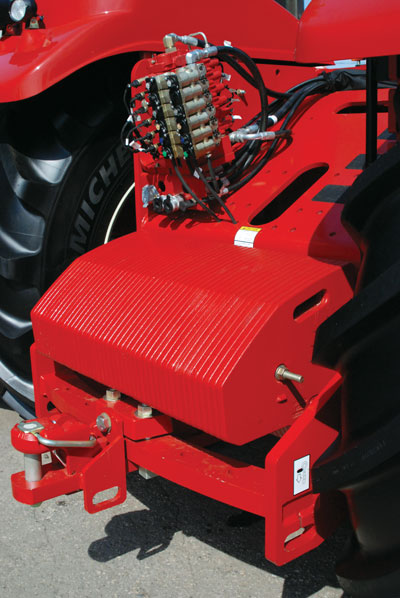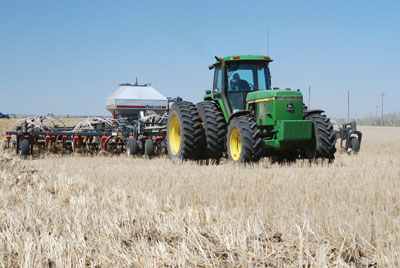
Tractors
Ballasting for better tractor efficiency
Weighting a tractor for optimum efficiency means improved pulling performance, less fuel consumption, and longer drive-train life. Yet, for many farmers, ballasting remains a once per tractor-lifetime scenario.
May 25, 2010 By Top Crop Manager
Weighting a tractor for optimum efficiency means improved pulling
performance, less fuel consumption, and longer drive-train life. Yet,
for many farmers, ballasting remains a once per tractor-lifetime
scenario.

|
|
| A properly ballasted tractor uses less fuel, lasts longer and improves tractor efficiency. (Photos by Bruce Barker) |
|
 |
|
| A mechanical front-wheel drive (MFWD) tractor should have weight distributed 40 percent on front and 60 percent on back. |
“For most folks, if the tractor ballast is looked at, it happens once
at the dealer,” says Roger Hoy, director of the Nebraska Tractor Test
Lab at the University of Nebraska at Lincoln.
Hoy explains that, ideally, a tractor’s ballast should be adjusted for
each field operation, but he also knows that may be impractical. As a
result, Hoy suggests ballasting for the most common field operation.
For many western Canadian farms, that likely means tillage and seeding
activities, especially for high- horsepower tractors.
Lawrence Papworth, an engineer with the AgTech Centre at Lethbridge,
Alberta, explains that the primary reason to assess a tractor’s ballast
is to control wheel slippage. Over-ballasting, which is the most
common, results in higher fuel consumption, sluggish tractor handling,
and premature drive-train problems. Over-ballasted tractor tires show
very little wear because they are not slipping in the soil.
An under-ballasted tractor will show excessive tire tread wear due to
excessive slip, and cannot deliver full horsepower to the drawbar. Fuel
is also wasted because of the excessive wheel slippage.
A rough guideline for wheel slippage is 10 to 15 percent for two-wheel
drive (2WD) tractors, and eight to 12 percent for four-wheel drive
(4WD) tractors. Papworth explains that these slippage guidelines
provide the most economical operating point where fuel consumption,
tire life, productivity and tractor durability are combined.
Estimate slippage
Slippage is relatively easy to measure in the field. The AgTech Centre provides this guideline for measuring slippage.
Mark the side of a drive tire with a vertical chalk line. Under normal
working conditions and on untilled ground, get the tractor and tillage
implement up to speed. Have a helper drop a flag beside the tire when
the chalk mark touches the ground. On the tenth tire revolution, drop
another flag on the ground when the chalk mark hits the ground.
Next, take the implement out of the ground, turn around, and drive back
alongside the tilled ground with the implement out of the ground. Using
the chalk mark as a guide, count the number of revolutions that it
takes for the tractor to cover the same distance while keeping the
tillage unit out of the ground.
Use the following equation to estimate slippage:
Percent slip = 10 minus the number of revolutions without load, divide by 10 and multiply by 100.
For example, if it took 8.75 revolutions with no load to cover the same
distance as 10 revolutions under load, the slippage would be 12.5
percent (10 – 8.75 divided by 10 multiplied by 100).
If the tractor is a 4WD or front-wheel assist, do the same thing on the front drive wheels to ensure slip is evenly balanced.
If wheel slip falls within range, the tractor is ballasted correctly
for the field operation. If it does not, consider changing the
ballasting.
Ballasting tips
Ideally, ballast could be changed for each type of field operation, but
that may be impractical, especially if calcium chloride is used in the
tires for ballast. However, many tractors now primarily use cast iron
ballast, which can be more easily added or taken off. Papworth says
that many of the high-horsepower tractors are much heavier than in the
past, so ballasting is more of a fine-tuning process to manage slippage.
Preliminary estimates for ballasting can be made based on horsepower
and travel speed. AgTech information indicates that, generally, higher
travel speeds require less ballast. The AgTech publication, Ballasting
Your Tractor for Performance, explains that “the mechanical properties
of the soil only allow so much deformation (slip) to occur in a given
period of time. For example, a faster rolling tire has less time to
cause deformation on a given area of soil; slip is reduced, and less
ballast is required.”
Papworth explains that at slower speeds, more ballast is required to transfer most of the tractor’s horsepower to the ground.
The AgTech publication explains that 95 to 110 lbs per engine
horsepower (79 kg/kW) is a rough starting point for estimating ideal
tractor weight including ballast at a speed of eight kilometres per
hour. The manufacturer’s recommendation on ballasting should also be
consulted. This estimate should provide a slip percentage somewhere in
the correct range when the tractor is fully loaded. But be aware of the
effect of different speeds: to get the same slip percentage at 6.5
kilometres per hour requires 163 lbs per horsepower (99 kg/kW) for
proper ballast; at 9.5 kilometres per hour, only 108 lbs per horsepower
(66 kg/kW) is required.
This guideline should be compared to the actual weight of a tractor.
The Nebraska Test reports also list the weights of unballasted
tractors. Growers can usually get a tractor’s shipping weight, complete
with additional equipment, from a dealer. A grain elevator scale is a
good way to check the actual weight if it is convenient.
Weight distribution between the front and back wheels also should not
be overlooked, says Papworth. The tractor type is important.
| Weight distribution for different tractor types | ||
| Type | Front | Back |
| 2WD | 25% | 75% |
| MFWD | 40% | 60% |
| 4WD | 55% | 45% |
Papworth says that over-ballasting is usually a more common problem,
because farmers are trying to squeeze out all the horsepower they can
from their tractor to pull large loads.
Another important point is to ensure tire inflation is correct.
Papworth says that once the proper ballast weight and distribution is
set, the tire pressure should be set for the corresponding weight on
each tire. Check the manufacturer recommendations for the weight
carried by the tires.
During the summer of 2010, AgTech in co-ordination with the
Agricultural Research and Extension Council of Alberta (ARECA) plans on
holding several ballasting demonstration throughout the province. Check
the ARECA website (www.areca.ab.ca) for further information.
*This article was provided by Alberta Research and Extension Council of
Alberta, with information compiled from the AgTech Centre Research
Update #725.